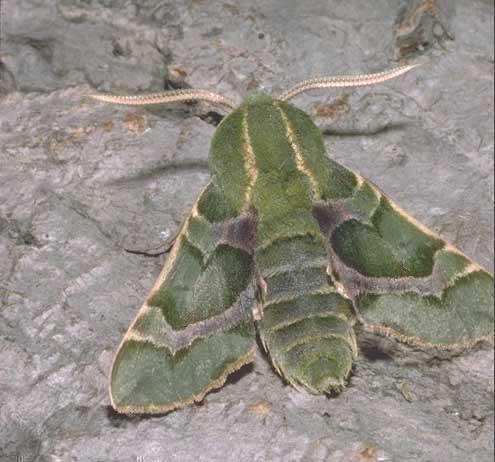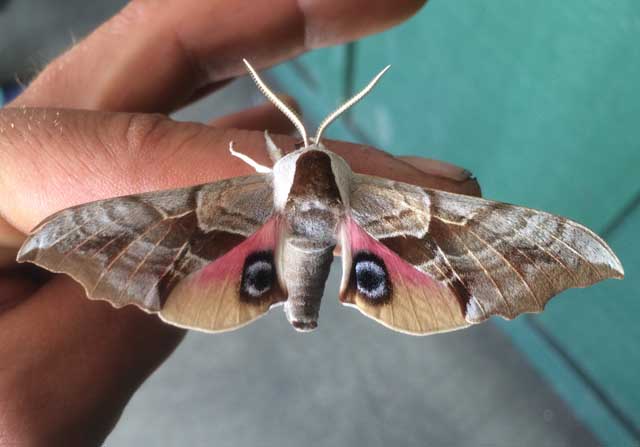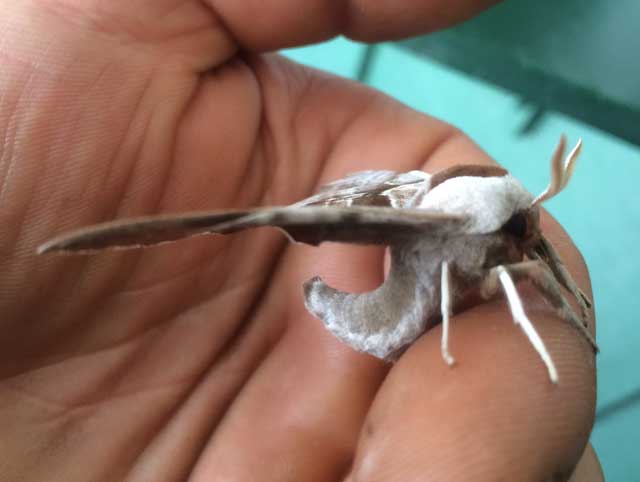Butte County, California
Sphingidae


Patience writes, "I was just linked to your site during a search to figure out what kind of moth we found. We just found him on our front porch. It was 12:35 PM, and it is only 51 degrees here, with down pouring rain, and 20 + mph winds. We live in Chico, CA on 5 acres.
"We have been receiving record rainfall for the past week. I donít know where he came from because yesterday was the only day in the past week that we saw the sun peek through briefly in between the showers, and according to what Iíve been reading they live on primrose, but Iíve havenít seen any flowers around here for weeks.
"It is definitely a Pacific Green Sphinx; it looks exactly like the first picture on your site, only his body is a little fatter. My kids put it in their butterfly habitat and have been looking at it. We were wondering their life span is, and can you make nectar to feed them? Any further information would be greatly appreciated."
I wrote back "It is the larvae (caterpillars) that feed on evening primrose. I suspect they only live as adults for five to seven days. I suspect they do not eat as adults; they probably live off fats stored from caterpillar days. I am surprised they would be flying so far north this early in the season. It may have been aided in flight by some strong winds from further south.
The following day Patience writes, "Thank you very much for the information. I thought it was quite interesting to find him in this
weather too, but we actually found another one around 6:00 this evening on the front porch soaking wet, and it was actually shivering.
"We brought it inside too and put it in the butterfly habitat with the other one."

Smerinthus ophthalmica male, Chico, Butte County, California,
March 20, 2015, courtesy of Adam Heichelbech, id by Bill Oehlke.

Smerinthus ophthalmica male, Chico, Butte County, California,
March 20, 2015, courtesy of Adam Heichelbech, id by Bill Oehlke.
It is hoped that this checklist, with the thumbnails and notes, will help you quickly identify the moths you have encountered.
A WO" after the species name indicates that I have no confirmed reports of this species in Butte County, but I (William Oehlke) expect that this moth is present.
A USGS indicates the moth is reported on the USGS website and/or in Moths of Western North America, #2. Distribution of Sphingidae of Western North America, revised, an excellent little booklet available through Paul Opler.
Please help me develop this list with improved, documented accuracy by sending sightings (species, date, location), preferably with an image, via email to Bill Oehlke.
Sphinginae subfamily
Smerinthini Tribe:
Macroglossinae subfamilyDilophonotini Tribe:
Philampelini Tribe:
Macroglossini Tribe:
|
Enjoy some of nature's wonderments, giant silk moth cocoons. These cocoons are for sale winter and fall. Beautiful Saturniidae moths will emerge the following spring and summer. Read Actias luna rearing article. Additional online help available.
Use your browser "Back" button to return to the previous page.
This page is brought to you by Bill Oehlke and the WLSS. Pages are on space rented from Bizland. If you would like to become a "Patron of the Sphingidae Site", contact Bill.
Please send sightings/images to Bill. I will do my best to respond to requests for identification help.
 Show appreciation for this site by clicking on flashing butterfly to the left. The link will take you to a page with links to many insect sites. |